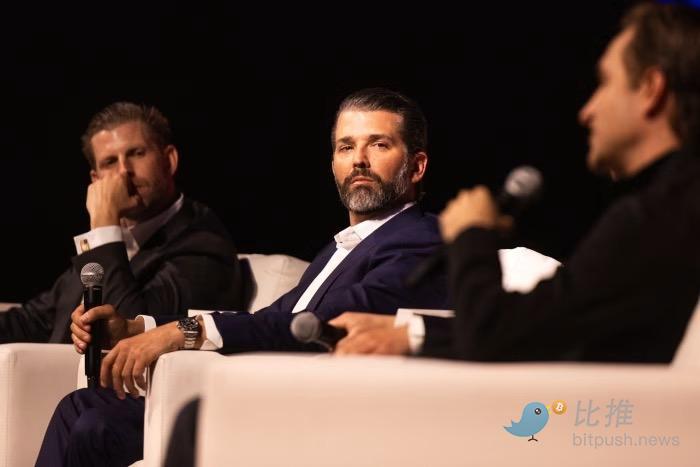Jessy, Jinse Finance
“They asked me for 50,000 U at the booth.”
After hearing the quote, Jack, the head of a Bitcoin DeFi project, decided not to purchase a booth at this year's Bitcoin Asia main venue. He spoke with me about his project at the Bitcoin Summit side event booth on the same floor as the Bitcoin Asia exhibition hall at the Hong Kong Convention and Exhibition Center. His project hadn't received much funding, and 50,000 U tokens wasn't a good deal.
This was my second year attending Bitcoin Asia, and Jack's second year in Hong Kong. The difference was that last year he had a booth at the main venue, but this year he only attended the side events.
Having attended the exhibition for two consecutive years, my most immediate impression is that the number of exhibitors at the main venue this year is significantly reduced compared to last year. At the Bitcoin Asia conference last May, the Bitcoin ecosystem hadn't yet shown signs of a bubble burst, boasting a "thriving ecosystem" and a plethora of projects. Layer-two chains, DeFi protocols, NFTs, and blockchain-based games were all emerging. This year, however, there were only about ten booths scattered around the exhibition area. "None of our booths are sold out this year," one exhibitor told me.
Unlike last year's diverse project portfolio, this year's largest exhibitors are mining machine manufacturers and their distributors, as well as several leading wallet projects that also participated last year. Their continued participation not only demonstrates the continued operation of these projects, but also demonstrates a stable cash flow and willingness to invest in promotional opportunities at Bitcoin Asia. Most of the once-hot "Bitcoin ecosystems" have become short-lived.
While the exhibitors were sparse and the event wasn't as lively as last year, there were still a large number of visitors. While the Bitcoin ecosystem was less of a hot topic this year, topics like "DAT," "RWA," "stablecoins," and "mining" remained popular. The presence of CZ and Trump's second son further ignited the atmosphere at the event.
The complete decline of the Bitcoin ecosystem
Last year, a blockchain gaming project team that had a large booth at the main venue told me that their project has essentially stalled. Back then, they promoted a DePIN mining concept—selling gaming consoles with the promise of mining while playing games—but the project ultimately never issued a token.
“There’s nothing we can do about being criticized. We dare not issue coins, and we can’t protect the price.”
This is precisely the dilemma facing many Bitcoin ecosystem projects: even after issuing tokens, it's difficult to provide investors with an explanation—the price of the token continues to fall. Investment institutions ABCDE, once heavily invested in the Bitcoin ecosystem, announced a halt to new investment in the first half of this year. Statistics show that the six projects it invested in, which had already issued tokens, have all performed dismally. Well-known projects like Merlin Chain and Babylon have seen significant declines from their peaks.
Jack expressed a similar view: these projects are often Ponzi schemes designed to raise money, disappearing within a few months. The absence of Bitcoin ecosystem projects from the main conference hall at the Bitcoin Asia conference was a reflection of this reality.
In contrast, Bitcoin mining offers greater certainty. However, with increasing mining difficulty and regulatory changes, this asset-heavy industry is no longer as hot as it once was. Following the Bitcoin halving in 2024, mining rewards will be reduced by 50%, and network hashrate will reach a new high, causing mining unit revenue to drop from approximately $0.12 per terahash (TH) to $0.049 per TH. In the first half of 2025, the cost of mining a single Bitcoin increased by over 34% year-on-year, exceeding $70,000. Mining companies are also seeking new avenues, including IPOs and transitioning to crypto treasury companies. A mining company employee told me that manufacturers are under immense pressure to attend conferences in the hope of gaining exposure and fostering collaboration, but the market remains a competition for existing capacity.
While the pressure is high, selling mining machines or providing one-stop services for mining farm construction are inherently more oriented towards the real economy. With a stable profit model, they are more likely to survive long-term.
Leading wallets like Unisat and Xverse, which have participated in both years, have managed to maintain their position, as they have secured a niche within the Bitcoin ecosystem. However, confusion remains a major concern. A Unisat employee told me, "The Bitcoin ecosystem is currently at a low point, and we don't feel like we have any direction. However, we still have to participate in the exhibition to maintain brand exposure and build our brand."
The new hotness is DAT
In contrast to the decline of the Bitcoin ecosystem, DAT has become a hot topic. Several prominent speakers mentioned it in their speeches, including CZ and Blockstream founder Adam Back.
This year, various crypto treasury companies have emerged, using financial instruments to raise funds and then purchase cryptocurrencies. Their stock prices are closely linked to the market capitalization of cryptocurrencies. Panelists believe this is a way to make crypto assets more accessible to traditional financial investors and is more attractive than direct cryptocurrency investment.
The arrival of Eric Trump, Trump's second son, was another highlight of the event. As the closing guest, his powerful speech drew enthusiastic responses. In it, he criticized Biden's incompetence, praised the Trump administration for its boom in cryptocurrencies, and predicted that Bitcoin would reach $1 million per coin. He had also previously attended the WebX2025 event in Japan, making his schedule very tight.
Thanks to these prominent guests, despite the relatively quiet booth area, the event still attracted a large number of visitors. Participation from outside traditional finance professionals also increased significantly. A friend at a brokerage firm told me, "For traditional finance professionals, the crypto industry is a hot commodity right now."
As a traditional financial center, Hong Kong saw major brokerages launch crypto services this year, and stablecoin pilots also attracted considerable attention. Even with a sharp decrease in exhibitors at the main venue, the crypto industry remained a hot topic.
However, perhaps precisely because of the high attention paid to the Bitcoin Asia event, the content of the guests' speeches at the venue was more conventional. For example, CZ speech at the side event held by the University of Hong Kong contained more critical and constructive opinions on Hong Kong's current policies than what he said at the Bitcoin Asia venue.
According to the South China Morning Post, Hong Kong Securities and Futures Commission Executive Director Yip Chi-hang and Hong Kong Legislative Council member Ng Kit-chung withdrew from Bitcoin Asia's activities after receiving instructions not to meet with Eric Trump, the son of US President Trump.
This may also reflect that, on the one hand, Hong Kong hopes to embrace crypto as a financial center and attract more industries and capital. However, on the other hand, it cannot completely escape the constraints of the broader environment and remains cautious and restrained in its policy expressions. The bustling and quiet Bitcoin Asia scene is both a microcosm of the industry cycle and perhaps a facet of Hong Kong's fluctuating role in the crypto world.







